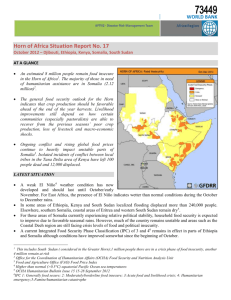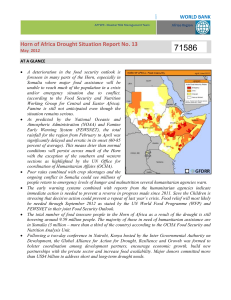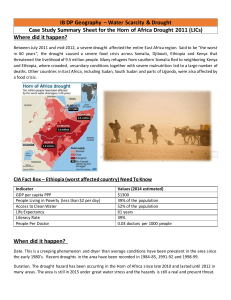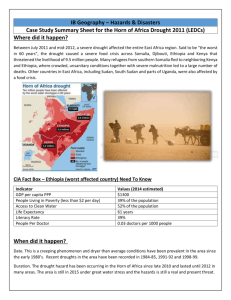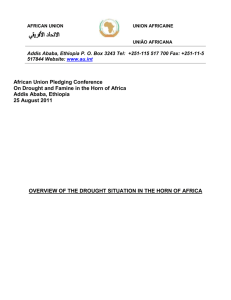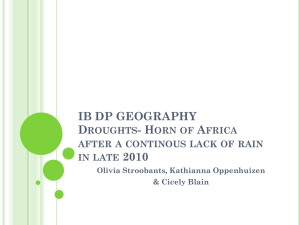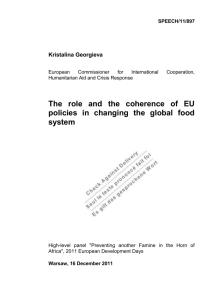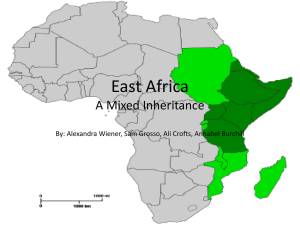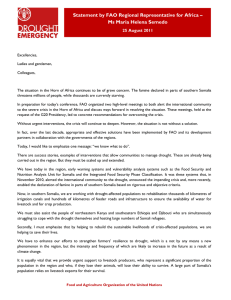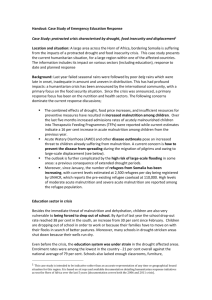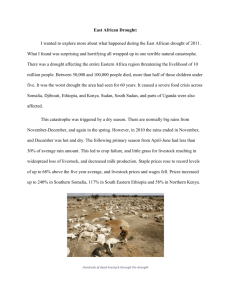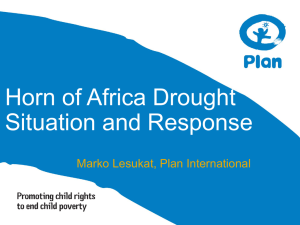HoA sitrep - World Bank
advertisement
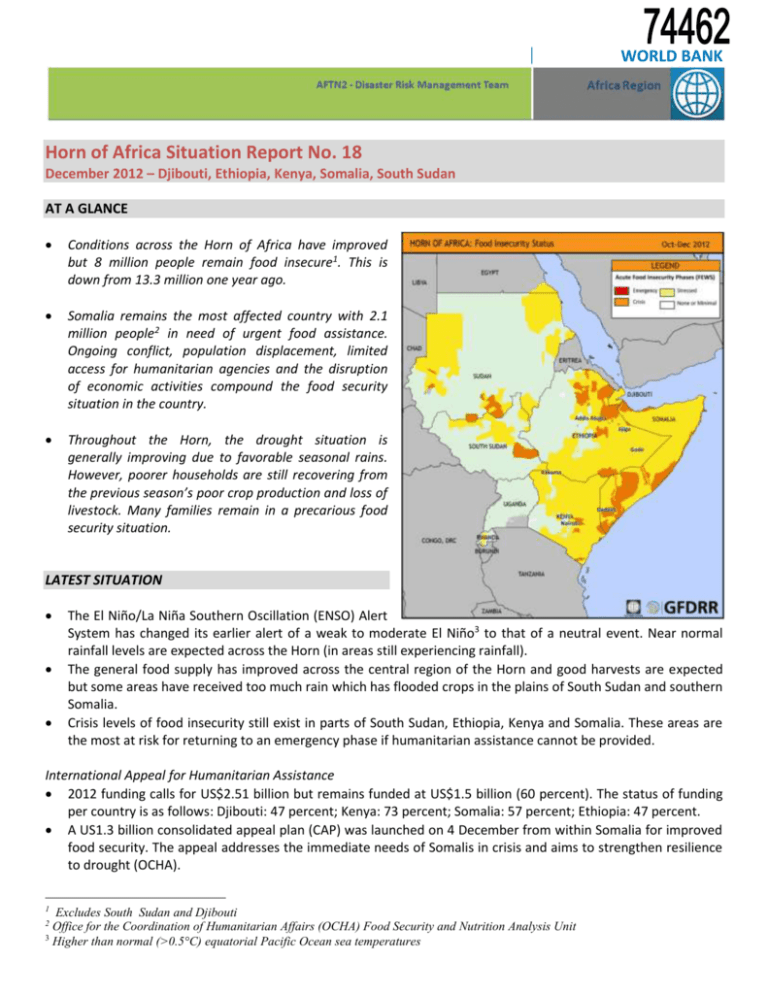
WORLD BANK Horn of Africa Situation Report No. 18 December 2012 – Djibouti, Ethiopia, Kenya, Somalia, South Sudan AT A GLANCE Conditions across the Horn of Africa have improved but 8 million people remain food insecure1. This is down from 13.3 million one year ago. Somalia remains the most affected country with 2.1 million people2 in need of urgent food assistance. Ongoing conflict, population displacement, limited access for humanitarian agencies and the disruption of economic activities compound the food security situation in the country. Throughout the Horn, the drought situation is generally improving due to favorable seasonal rains. However, poorer households are still recovering from the previous season’s poor crop production and loss of livestock. Many families remain in a precarious food security situation. LATEST SITUATION The El Niño/La Niña Southern Oscillation (ENSO) Alert System has changed its earlier alert of a weak to moderate El Niño3 to that of a neutral event. Near normal rainfall levels are expected across the Horn (in areas still experiencing rainfall). The general food supply has improved across the central region of the Horn and good harvests are expected but some areas have received too much rain which has flooded crops in the plains of South Sudan and southern Somalia. Crisis levels of food insecurity still exist in parts of South Sudan, Ethiopia, Kenya and Somalia. These areas are the most at risk for returning to an emergency phase if humanitarian assistance cannot be provided. International Appeal for Humanitarian Assistance 2012 funding calls for US$2.51 billion but remains funded at US$1.5 billion (60 percent). The status of funding per country is as follows: Djibouti: 47 percent; Kenya: 73 percent; Somalia: 57 percent; Ethiopia: 47 percent. A US1.3 billion consolidated appeal plan (CAP) was launched on 4 December from within Somalia for improved food security. The appeal addresses the immediate needs of Somalis in crisis and aims to strengthen resilience to drought (OCHA). 1 Excludes South Sudan and Djibouti Office for the Coordination of Humanitarian Affairs (OCHA) Food Security and Nutrition Analysis Unit 3 Higher than normal (>0.5°C) equatorial Pacific Ocean sea temperatures 2 Situation Analysis As conditions ease in certain areas of the Horn, it is important to maintain humanitarian efforts to ensure longer term resilience to disasters. Regional agencies most involved with developing a long-term response with affected populations are the African Union, Intergovernmental Authority on Development (IGAD), European Union, United Nations and the African Development Bank. For households in the recovery phase, any shock could put them quickly into a crisis food security situation as their coping mechanisms are limited. For areas already in a crisis situation, continued humanitarian assistance is needed along with further efforts to bring stability to conflict zones, especially in Somalia. COUNTRY BY COUNTRY SITUATION Djibouti 70,000 people across the country area affected by food insecurity. However, the food security situation has been stable due to heavy rains across much of the country since November. The poor rainy seasons from 2011 and early 2012 continue to impact the pastoralists who are not able to recover as quickly from their loss of assets (mainly cattle). Most of the country remains in a stressed food security situation which is a slight improvement from November. It is anticipated that 60-70 percent of the pastoral areas will receive some form of food assistance through to March 2013. This should improve household access to food combined with the increased harvests (FEWSNET). Ethiopia At present an estimated 3.8 million people will need emergency food assistance. In the Harerge and Ormomia regions, the situation is deteriorating. Local government officials are reporting high levels of food insecurity in these areas due to poor seasonal rains and lack of recovery from the previous drought. Current food relief efforts are able to reach 2.8 million including in the Somali region. The seasonal rains have been normal across much of the country and have helped to replenish water sources and regenerate pastures. Most harvests are expected to be above normal excluding zones not receiving adequate seasonal rains. A major multi-sectoral household needs assessment is underway in Afar, Amhara, Beneshangul Gumuz, Gambella, Oromia, SNNP, Somali and Tigray. Results should be ready by 14 December. Kenya 2.1 million people remain food insecure. The majority of humanitarian assistance is focused on refugees, small-scale farmers and pastoralists in the southeastern and coastal areas. Improvements are expected across the country however, as households slowly recover from poor rains experienced earlier in the year. Pastures are already seeing an improvement and livestock trade is increasing. Overall food prices have decreased slightly in all areas although they remain high compared to the five year average. The UN World Food Programme is reporting that in the northern pastoral zones, households have to use more coping strategies due to an increase in food shortages. Approximately 96,000 refugees remain in camps with a steady increase coming from South Sudan. Kenya hosts 566,487 refugees; most of whom are from Somalia fleeing drought and conflict. Page 2 Somalia The food security situation remains fragile even though there has been a slight improvement following favorable rains. The latest Food Security and Nutrition Analysis Unit report maintains 2.1 million people are still in need of immediate humanitarian assistance. The El Niño effect from August/September has had an overall positive impact on the country with improved rains and good distribution. However, there must be maintained momentum from successive good harvests in order for households to recover from the recent effects of the drought. The UN High Commissioner for Refugees (UNHCR) estimates that 1.1 million people remain internally displaced due to conflict and drought conditions and another 1 million are living as refugees outside of the country. Displaced people in the country remain most at risk and the ongoing conflict situation in many areas of Somalia is compounding the situation. The increase in activity from the African military forces (AMISOM) and their efforts to secure additional parts of the country mean more population displacements are likely over the coming months. South Sudan Favorable rains have improved the food security situation in the Western, Central and Eastern regions of the country (FEWSNET). However, flooding has displaced nearly 260,000 people in the western plains area and upper Nile region. Overall, 3 million people are still in need of immediate humanitarian assistance. Increased conflict along the border areas of Sudan and Ethiopia is creating additional displacement of people. This is expected to worsen as militias move to areas with better resources following traditional pastoral routes. WORLD BANK RESPONSE KEY ACTIONS The World Bank’s response to the drought is built on a strong collaboration with the national governments of the region as well as the U.N. agencies, the African Union, the IGAD, the European Union, International Federation of Red Cross Red Crescent Societies (IFRC), regional and non-governmental organizations. The World Bank is supporting IGAD for a regional disaster resilience and sustainability program that aims to increase the Authority’s capacity for critical support to member states for drought and disaster management planning and capacity building. This is done through a grant from the Global facility for Disaster Recovery and Reconstruction (GFDRR). The Bank has worked with the UNHCR to support health and nutrition in refugee camps through a US$30 million Horn of Africa Emergency Health & Nutrition Project. The Bank is also working with the UN Food and Agricultural Organization (FAO) to support drought relief and recovery through the Drought Management & Livelihood Protection Project. The project is funded through a US$9 million grant from GFDRR (US$5 million) and State and Peace Building Fund (US$4 million). Overall: Short term response phase is now over. To date, an estimated US$233 million has been disbursed from 15 projects; US$190 million for rapid response (9 projects which are now complete and funds fully disbursed) and US$43 million (6 projects) for medium to long term recovery. The rapid response phase provided immediate benefits to the most vulnerable populations. In Ethiopia, the Productive Safety Nets Project II promoted enhanced food consumption for food insecure populations. Page 3 The Regional Emergency Health & Nutrition Project provided immediate health and nutrition support for refugee populations in countries bordering Somalia. In Ethiopia, the triggering of the contingency risk financing facility enabled improved food consumption for 6.5 million chronic and 0.3 million transitory food insecure people. The Kenya Health Sector Support Project, which is currently ongoing, is the first WB project supporting large scale nutrition interventions targeting the resident populations in Kenya. Country-specific (some information repeated since last update for information purposes) Ethiopia: 70 federal and regional government staff received training in the Post Disaster Needs Assessment methodology in June 2012. This training included a ‘hands-on’ learning experience and field trip to drought affected Boset Woreda (district). This capacity building exercise enhanced the government’s capacity to conduct drought and other disaster related impact assessments. CRW resources were disbursed to the Productive Safety Net Program to replenish the risk financing facility of the program. Kenya: Kenya Agricultural Productivity and Agribusiness Project: drought related activities are being scaled up in the identified districts. Kenya Agriculture Drought Recovery Project: this project is being scaled up with CRW funds in response to the continuing drought situation. Health Sector Support Project: the project is ongoing and is one of the first projects supporting large scale nutrition interventions targeting the resident populations who are equally vulnerable compared to refugees in the camps. Somalia: The US$9 million Somalia Drought Management and Livelihood Protection Project is supplying 97,008 people with cash-for-work activities for the rehabilitation of productive infrastructure. The project supported an additional 210,000 people in crisis with seeds for drought tolerant crops. All seed distributions were completed. WB Horn of Africa Drought Response Contacts Doekle Wielinga, AFR DRM Coordinator, AFTN2, WB Washington DC, AfricaDRM@worldbank.org Disaster Risk Management Website Sources: OCHA, Relief Web, FEWSNET, UN agencies, press releases from various media sources, WB Staff Page 4
